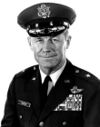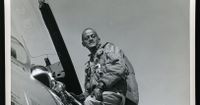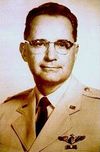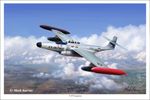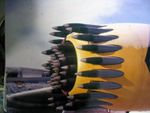Northrop
and should NOT be used for any reason other than reading enjoyment |
| Palmdale Nexus | ||
|---|---|---|
A Personal Note from Robin
| ||
Palmdale Test Flight Facility was designed to provide several aircraft companies a place to perform "final inspection" flights. These were flights to prove the "airworthiness" of an aircraft just prior to acceptance by the Air Force or Navy. Palmdale was chosen because it "had 350 fly-days" per year.
On the fifteen or so days that "the all-weather jet interceptors" were grounded, most of the pilots would walk out to the flight line, jump into their personal Cessnas and Piper Cubs and fly home.
These were some of the Test Pilots of the mid-50s.
Chuck Yeager
Chuck Yeager was, to me, a marvelous man. He held more flight test records than almost any man alive.
When the "National Advisory Committee for Aeronautics" (NACA, the precursor to NASA) went looking for "Astronauts" with the "Right Stuff", Chuck was eliminated because he didn't hold a College diploma at that time. I think his "failure to qualify" was one of the things that drove him to be the pilot that he was.
Chuck, Glennis, and their kids visited Two Shay Ranch and Pancho's regularly.
Johnny Whitehead
Lt. Col. John Lyman Whitehead (born Lawrenceville, Virginia, ✦May 14, 1924 – †September 6, 1992, in Sacramento, California). He was a Tuskeegee airman (he flew a P-51 Mustang with the 332nd Fighter Group), the first African American test pilot, and first African American jet flight instructor in the United States Air Force, and the first to fly the Boeing B-47 Stratojet bomber. His nickname was "Mr. Death."
From August 1984 to January 1992, Whitehead served as a California State Park Commissioner.
Johnny Whitehead was a Test Pilot for Northrop. He had taken one of the F-89s up, and when he started to land, the landing gear "down and locked" light didn't come on. He called the flight Control Tower (FCT) for help. The FCT was located on the roof and near the edge of a very, very large aircraft hangar. When he flew over the building, several people were standing on the roof with field glasses, trying to determine the status of his landing gear. He flew over the hanger, but the people on the roof could not tell if the gear were actually "down and locked."
The tower asked that he fly over again, but perhaps "just a little bit lower and slower." On the second pass, the jet engine blew gravel off the roof. As he passed over the edge of the hangar, he hit a downdraft. Being a good test pilot, he attempted to avoid crashing into the ground and losing the aircraft. What does a good pilot do? He hit the after-burners, which blew the side of the hangar away.
Colonel John Stapp
Colonel John Stapp (11 July 1910-13 November 1999) was another of the Edwards/Palmdale people. In a pioneering rocket sled experiment, he was accelerated to 632 miles per hour in just five seconds and then brought to a complete halt in 1.4 seconds. He is also credited with creating "Stapp's Ironic Paradox" ---
- "The universal aptitude for ineptitude makes any human accomplishment an incredible miracle."
A New York Times obituary (November 16, 1999 by Douglas Martin) included a story about an assistant to Col. Stapp, one Capt. Edward A. Murphy, Jr., who had incorrectly installed some sensors used on Stapp in a 1949 high-speed sled ride. The sensors could be installed in one of two ways, and Murphy managed to place every single sensor in the wrong position. And so it was that Col. Stapp, staggering off of the sled with blood oozing from his eyes, learned that the sensors all read "zero"--he had been tortured for nothing. Capt. Murphy remarked, "If there are two or more ways to do something and one of those results in a catastrophe, then someone will do it that way," the original statement of the well-known Murphy's Law, "If something can go wrong, it will go wrong - and at the worst possible time."
Dr. Stapp also participated in wind-blast experiments, in which he flew in jet aircraft at high speeds to determine whether or not it was safe for a pilot to remain with his aircraft if the canopy should accidentally blow off. Dr. Stapp stayed with his aircraft at a speed of 570 mph (917 km/h), with the canopy removed, and suffered no detrimental effects from the wind blasts. He also supervised research programs in the fields of human factors in escape from aircraft and human tolerance to abrupt acceleration and deceleration.
In later life, John was very involved with inventing and designing safety features for automobiles and is the "Father of the Car Crash Test Dummies."
F-89 Down
There was one particular F-89 that seemed to have continuous problems. The last day this particular plane flew, my mom had loaded the kids into the car and headed up to the Northrop facility.
Being the Facilities Inspector, my dad had rigged both of the family cars with radios so he could listen to "pilot chatter". We were parked near the runway, listening to the radios and waiting for my dad. The radio announced that the flight was coming in hot with a declared emergency, the hydraulics were gone so they had no way of deploying landing gear. The plane had two pylon fuel tanks which were nearly full. Since they had no hydraulics, they couldn't jettison the tanks. The lack of hydraulics made the plane nearly impossible to handle in flight. A decision to "land immediately" was made, and the airport went code three. The fire department rolled every piece of equipment they had, and they foamed the runway. I remember my brother Phil (who had a "truck fetish") yelling, "Look, Mom. They're bringing out the "BIG" LeTourneau fire trucks and ambulances today!" and my mother turning a kind of ashen color and yelled(?), "Shut up, Phil."
The plane approached the runway; they jettisoned the canopy using explosive bolts and landed midfield. The lack of landing gear meant the pylon tanks were scraping on the runway, and the tanks ruptured, spilling av-gas onto the runway behind them. The jet engines set the spilling av-gas aflame. When the plane slowed, Johnny Whitehead climbed out onto the left wing and my father on the right. They decided they would "fall" off the backside of the wing onto their parachute backs while the plane was still moving, hoping to leave it before the flames caught up with the plane and the ruptured pylon tanks.
The plane had slowed to about thirty or so miles per hour, and they stepped backward and off the wings. My dad cleared the plane and ran away to the right side of the plane and safety. Johnny cleared the plane and, seeing my father running to safety, followed him: through the flames gaining ground on their stricken aircraft.
Fortunately, the only human injuries were a sprained ankle, a little "road rash" for my dad, and singed eyebrows for Johnny Whitehead.
The plane was significantly damaged (beyond repair), so it was towed to the southeast end of the field, and any "survivable avionics" were removed. For several years after their crash, the plane was used by the fire department for training purposes. They would pour av-gas and diesel fuel over the plane, set it afire, and then practice extinguishing it.
The House on Sweetbriar
Our house on Sweetbriar in Palmdale was one of the last houses within the city. Beyond our house was pretty much an open desert. We could hear and see the jet aircraft flying, breaking the sound barrier, and crashing. Palmdale was losing one or more pilots per month.
Growing up in Palmdale meant that you went to school with kids who had last names that fill today's history books about early space flight, and you got dressed up and went to the funeral of another of your "uncles."
It was with great pride that I can say I knew many of them. They were all part of a "brotherhood" that was nearly impossible to join but very easy to leave --- you only had to make one little mistake.
See also [ The Right Stuff ]
Chat rooms • What links here • Copyright info • Contact information • Category:Root
